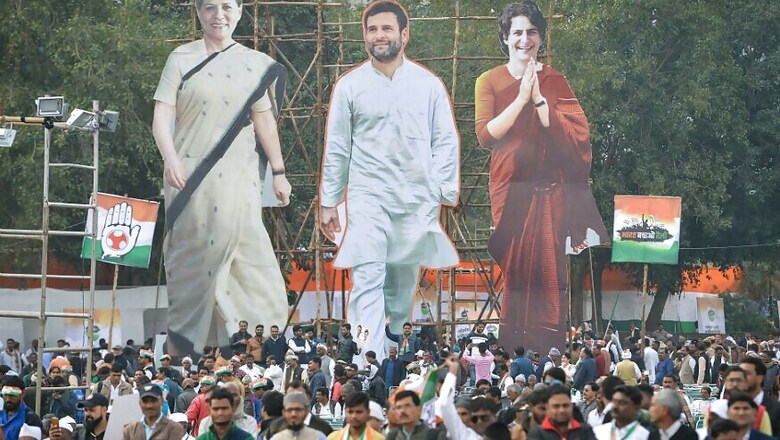
views
The meeting of like-minded opposition parties called by Congress president Sonia Gandhi on January 13 to craft a joint strategy on the ongoing student protests, the new citizenship law, the National Register of Citizens and the National Population Register was in the news for all the wrong reasons.
The focus remained on political parties that failed to turn up for this crucial meeting and not on those who attended, a fact that was gleefully pointed out by the Bharatiya Janata Party (BJP).
Undoubtedly, 20 political parties attended the meeting, but the absence of the Trinamool Congress, the Samajwadi Party, the Bahujan Samaj Party, the DMK, the Shiv Sena and the Aam Aadmi Party was glaring.
While BSP chief Mayawati has been maintaining a distance from the opposition parties for some time now, West Bengal chief minister Mamata Banerjee had declared a few days ago that the TMC would boycott the joint strategy session.
The DMK and Shiv Sena’s absence was, however, mystifying. While Shiv Sena is a newly-acquired coalition partner, the DMK has been a steadfast ally and a regular at joint opposition meetings. This is despite the fact that all these parties have rejected the Citizenship Amendment Bill, the proposed NPR and the NRC.
Sonia Gandhi obviously believed that since most political parties are on the same page on these contentious issues, this was the right time to bring together opposition parties on a common platform and work towards the formation of a coalition of like-minded secular parties. After all, Sonia Gandhi had pulled off a similar feat in 2004 when she had personally approached opposition leaders which eventually led to the formation of the United Progressive Alliance (UPA). The coalition was in power for two consecutive terms.
But Sonia Gandhi failed to achieve the same result this time. The question then arises is: why are opposition parties reluctant to respond to the Congress president’s call for united action even though they are ideologically aligned on the issue of the citizenship law and the NRC. In this instance, the primary factor is not ideology. It is about the leadership of the proposed coalition and the battle for space at the local level.
Unlike in 2004, it is becoming increasingly difficult for the Congress to emerge as an anchor of an opposition coalition. Though regional parties are well aware that as a pan-Indian party, an alternate formation will have to necessarily include the Congress, they are unwilling to concede the leadership role to it.
The Congress is a pale shadow of its old self today and the other opposition parties obviously want to take full advantage of this situation. They would be willing to do business with the grand old party, but on their own terms. More importantly, there is lingering fear among the regional parties that Rahul Gandhi will return to helm the Congress once again and they are not ready to accept him as the coalition head or its prime ministerial candidate.
Opposition parties also have difficulties in banding together at the national level when they are fighting each other in the states. This was evident in the run-up to the 2019 Lok Sabha elections when Mamata Banerjee and Rahul Gandhi agreed to fight unitedly at the national level, but, at the same time, maintained that they would battle each other in West Bengal. And it is this battle for space which kept Mamata Banerjee away from the January 13 meeting of opposition parties convened by Sonia Gandhi.
The Trinamool Congress chief is currently focused on next year’s assembly election in her home state. She clearly does not wish to share a platform with her local adversaries -- the Congress and the Left parties -- especially at a time when the Trinamool Congress is showing signs of recovering lost ground.
Similarly, the Arvind Kejriwal-led AAP had no intention of playing second fiddle to the Congress when it is a clear frontrunner in the upcoming Delhi assembly elections.
The contradictions in the opposition camp also showed up in the case of the DMK which is currently engaged in a war of words with the Tamil Nadu unit of the Congress over seat-sharing in the local body elections.
Though the Congress is a marginal player in Uttar Pradesh, both Samajwadi Party chief Akhilesh Yadav and BSP supremo Mayawati have reservations about joining hands with the grand old party. Even when the SP and BSP decided to bury their differences and work together in last year’s general elections, the two parties deliberately kept the Congress out as it brought nothing to the table.
While the Congress wanted Akhilesh Yadav and Mayawati to demonstrate flexibility in giving it a seat on the high table, the party was unwilling to do the same in Madhya Pradesh, Rajasthan, and Chhattisgarh. On her part, Mayawati is doubly miffed with the Congress, particularly after six BSP legislators in Rajasthan joined the Congress. Priyanka Gandhi Vadra’s regular forays into Uttar Pradesh have also not gone down well with Mayawati who feels the Dalits could gravitate to the Congress once again.
It is still early days to predict whether opposition parties can unite. The ground situation may well compel them to band together once the 2024 Lok Sabha election draws closer. But if past experience is anything to go by, it will be an uphill task to bring together the disparate political parties for a united fight against the BJP.
(Author is a senior journalist. Views are personal)




















Comments
0 comment